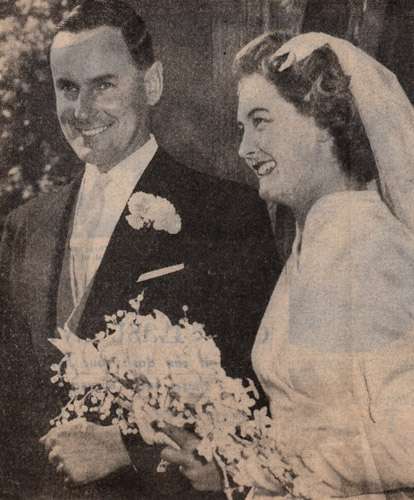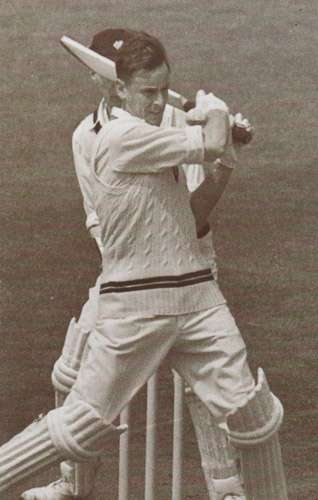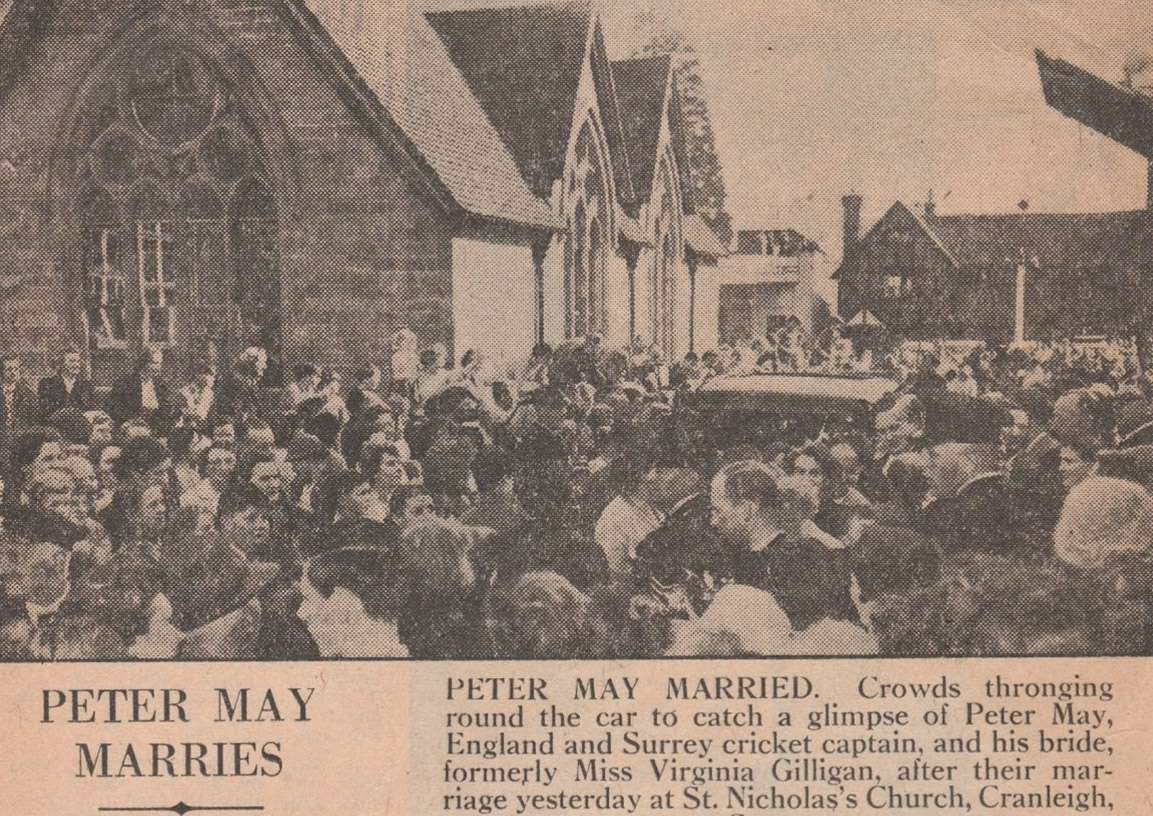
The Daily Telegraph’s reporting of the wedding
Cranleigh is not often able to enjoy a celebrity wedding. So it made the most of the marriage of England and Surrey cricket captain Peter May to local girl Virginia Gilligan in the parish church on Friday April 24th 1959. Virginia came from Shamley Green, and was a distinguished show-jumper who had taken part in the Badminton Horse Trials just a few days previously. Her father, Harold Gilligan, had played cricket for Sussex and England before the Second World War. Peter and Virginia intended to set up house at Briarfield on Cranleigh Common, overlooking the cricket pitch.
Peter May was a stylish and intelligent batsman, and a joy to watch. Two years previously, he had saved England from certain defeat by the West Indies at Edgbaston, in a memorable innings. He batted for ten hours on the third, fourth and fifth days of the first Test match, scoring 285 runs not out. In the course of this innings, he worked out a way of successfully playing the West Indies spin bowler, Sonny Ramadhin, who never subsequently posed the same threat to England.
Peter May and Virginia Gilligan (Surrey Advertiser, in the Claude Blogg Papers)
His wedding came after a disappointing winter tour of Australia, when England had unexpectedly lost the Test series, amid controversy over the bowling action of one of Australia’s bowlers.
The wedding was on a Friday, instead of a Saturday, as many of the guests would be playing in cricket matches the next day. In the streets of Cranleigh, shops were decorated with flags and posters congratulating Peter May. Village children were given the day off school, so that their playground could be used as a car park, and they thronged the churchyard carrying cricket bats, on which they hoped to collect autographs. The traffic flow and parking arrangements were controlled by Inspector Norman Lock of Godalming, who later came to live in Cranleigh and play cricket for the local team. It was estimated that 2,500 people lined the High Street.
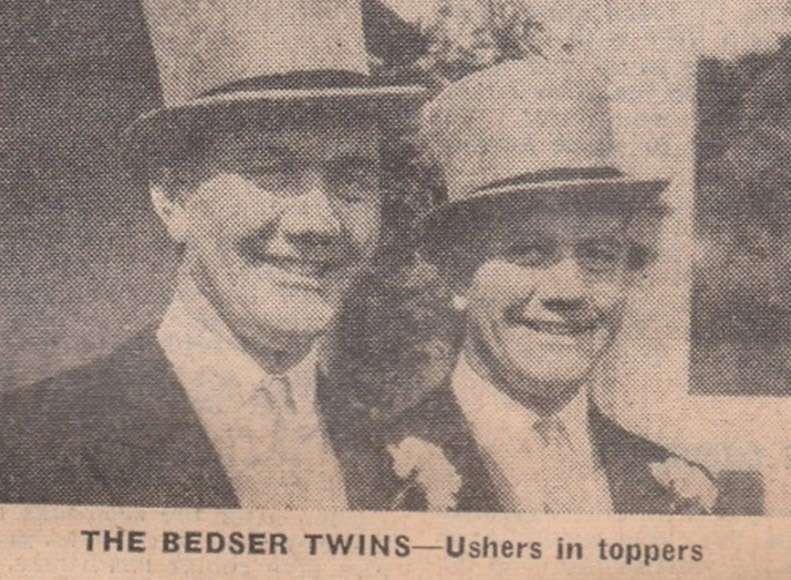
What brought these crowds was the hope of catching a glimpse not only of Peter May and his bride, but also of the world-famous cricketers among the guests. Perhaps forgotten now, these players set pulses racing at the time: Colin Cowdrey, Ted Dexter, Denis Compton, Trevor Bailey, Godfrey Evans and John Warr were household names in 1959. The Bedser twins, Alec and Eric, were among the ushers. For all these stars to be in Cranleigh was the stuff of dreams. The churchyard was swarming with photographers.
The event made headlines in all the local papers, and also in the national press. In the custom of the times, readers were given full details of the bride’s dress: 20 yards of white satin – ‘nearly enough material to cover a cricket pitch’. We learn that the gown required eight fittings, and was finished a week before the wedding. The bride’s mother designed the dresses of the four bridesmaids, who included one of Virginia’s sisters. The church was ‘beautifully decorated’ with stocks, carnations, roses and freesias. The organist played Wagner’s ‘Bridal March’ from ‘Lohengrin’ and Mendelssohn’s ‘Wedding March’. And the couple left the church to the ‘rounds and Grandsire triples’ of the bellringers.
Peter B.H. May (A. Hill, Peter May (1996))
As the spectators dispersed after the service, 320 guests enjoyed the wedding reception at the Gilligan family home, Franklin’s, Stroud Green. Peter and Virginia left for their honeymoon, variously given as ‘Scotland’ or St Mawes, Cornwall.
Records are made and broken, though May’s 285 not out stood for 33 years as the highest score by an England captain. Cranleigh is justifiably proud of Peter May. His first-class cricket career – 1950-63 – was cut short by serious illness and was relatively brief, but in that time he had a batting average of over 50, hit 85 centuries for Surrey and England, and helped Surrey win seven Championships in the 1950s. After his retirement, he brought the occasional team of celebrities to play on Cranleigh Common (including Harry Secombe and Eric Sykes), but after a few years he moved to Liphook in Hampshire. He had a tough time as Chairman of the England Selectors, in 1982-9, and died of a brain tumour in 1994, aged only 63.
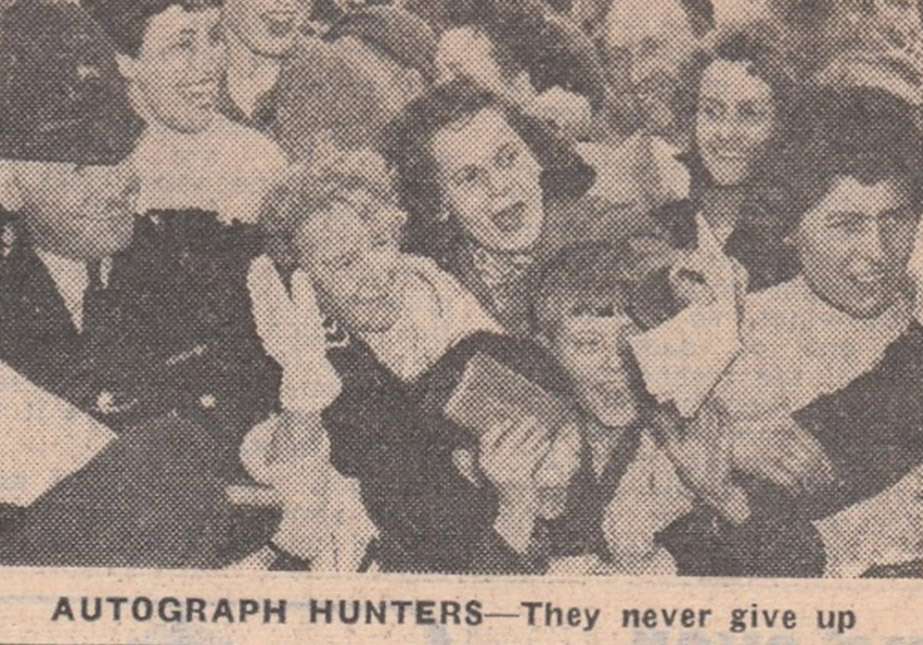
The police and the people (Daily Mirror)
By all accounts, it seems to have been a happy marriage. Peter and Virginia had four daughters, several of whom had international success in horse-riding.
(With thanks to Doug Lock for information and advice. All newspaper cuttings are from the Claude Blogg Papers, in the custody of the Cranleigh History Society.)
The Cranleigh History Society meets on the second Thursday of each month at 8.00pm in the Band Room. The next meeting will be on Thursday October14th, when David Barry will speak on ‘Ireland-England links since the 1600s’.

